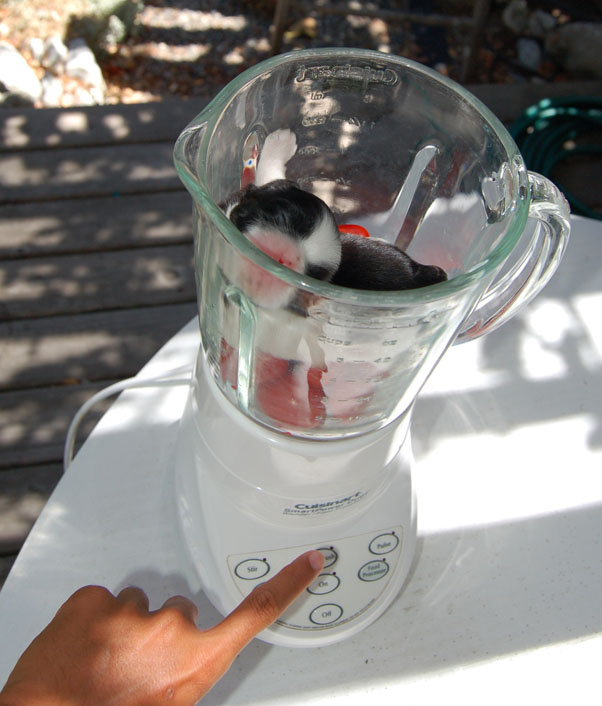
Young “Chunk” reenacts a dramatic scene from “The Goonies”.
Hit puree!
i-puppy
She fell asleep right on the keyboard. More shameless puppyblogging to come…

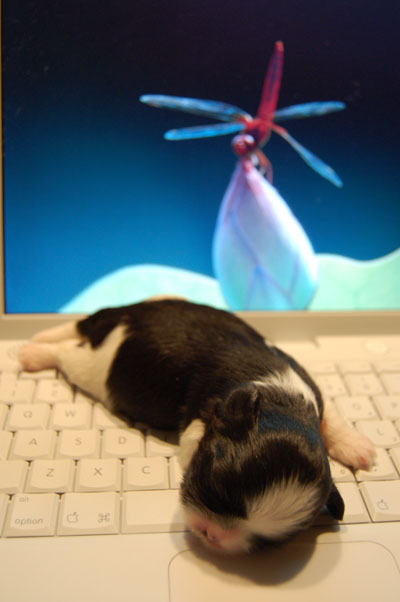
Opening Bolsa Chica
Up until a few days ago, much of Bolsa Chica was closed off to the public, so when I heard that they had opened it up I went to go check it out. The water under the bridge is murkier because the water is now able to get into and out of the estuary a bit easier, now that they have widened the opening to the ocean. You can already see a difference.
We saw about 6 stingrays in different places, all within a 30 minute span. This one seems to be missing his tail.
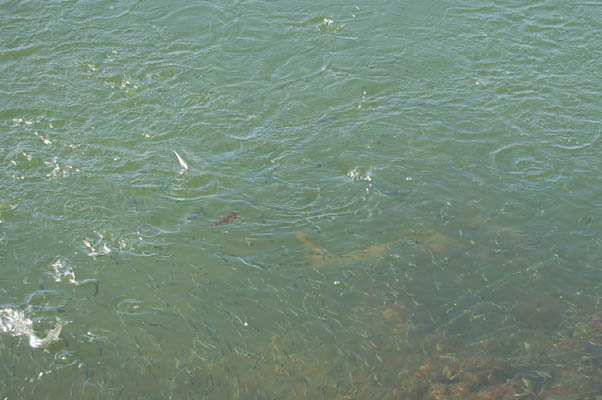
Something was scaring all of the smelt, and we couldn’t quite make it out. Whatever it was, it was just shy of 2 feet long.
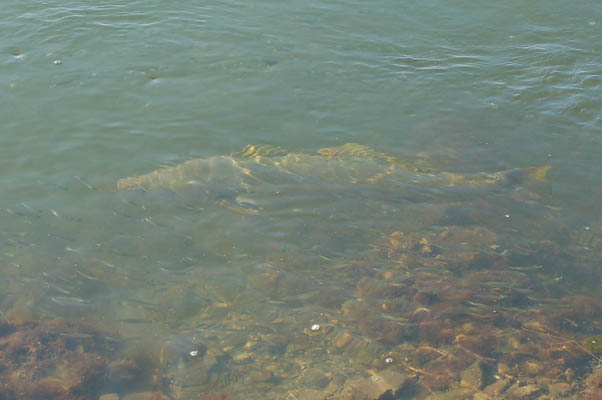
Upon careful inspection, it turns out to be a white sea bass! I have never seen these in Bolsa Chica before. And there were a bunch of them munching on the the smelt!
A few days ago, a school of bonita came up next to the docks in Newport and attacked the smelt as I was teaching a class. The frenzy only lasted 10 seconds, and when it was finished, there were a bunch of baitfish flopping around on the dock. This was exactly how it was in Catalina last weekend, except I have never seen this happen in front of the Sea Base or Sailing Center in the 10 years that I’ve been around this area.
I’m taking these unusual sightings as a good omen for the fisheries along the coast. It looks like things are starting to recover. It’s about time.
Pictures from the road
All of these pictures were taken from the road as we traveled around Kyushu. Though the destinations were all great, getting there was half of the fun. These are some of the passing moments that we witnessed on our road trip, complete with commentary.
A old horse in Yufuin pulls an endless procession of tourists around town. This is some tired basashi.
The JSDF and other Jeep enthusiasts regularly drive their vehicles in the mountains of Kumamoto and Oita. In these areas, you can really put an ORV to the test.
The “Mika” sits in front of a massive ship on the coast of Oita.
Japanese construction workers dress like the Beastie Boys in their video for “Intergalactic”. Or maybe it’s the other way around.
Many of the bridges have fish on them. This one looks like a sardine.
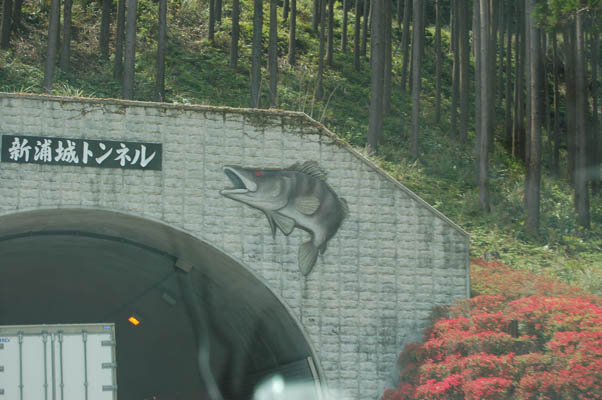
“Kick his ass, Sea Bass.”. At least, I think this one is a sea bass.
If my little sister or younger cousins owned a storage container, they would probably do something like this to it.
Work is constantly being done on the two lane highways, and they use timed stoplights to direct traffic through parts where one lane is closed off. This is a good idea, except when you get stuck at one of these and have to wait a few minutes to proceed, even if there is no one else on the road. Sometimes people get impatient and go on a red. If you have the green, this can be a problem.
We barely made it across this narrow bridge. It was only just wide enough to accommodate our car.
Three motorcycle cops bust this guy on the stretch of expressway leading into the SeaGaia resort in Miyazaki. If you are traveling down this road, watch your speed. There are a bunch of speed traps, and an abundance of police officers riding bikes.
Driving through Miyazaki reminds me of home, with the beautiful beaches lined with tall palm trees.
Swans guard the coastline of a volcanic lake in the countryside of Miyazaki.
This would be a great bridge to take pictures of an old RX-7, hachiroku, or NSX. Having none of these handy, the Familia has to make do.
This antique pump is still in use. Sometimes, a word or simple phrase in Japanese is so much easier to convey one’s sentiments than in English. In this case, that would be “monomochigaii”.
Sometimes tunnels will focus the signal given off from radar guns positioned just outside of tunnels. Often times, speed traps are set just outside of the tunnels and around a bend, so it is wise to watch your speed when you come out.

Tonkatsu? Shabu shabu? Yakiniku? These are the questions that go through my mind as we pass a truck carrying some pigs.
I love these animatronic dummies that pose as construction workers and cops. Often I have had the impulse to take one home for my living room, but have always exercised self-control.
Whenever I drive by a truck carrying petroleum products, I imagine what would happen if it got hit by a car, a carefully placed bullet, or a missile, and how much it would suck to be in close proximity to it if this happened.
Here’s a picture of my former residence that I took while driving through Ubuyama. It still looks the same.
A fire k-car. There are smaller fire vehicles, but this one is pretty compact. These firefighters were taking a break on Daikanbo, eating soft serve and enjoying the sweeping view of the caldera.
I think it’s kind of cool that this motorcycle group has boy’s day decorations on their bikes. Friendly bikers are so much more pleasant than scary ones. Only in Aso…
Torii of Kyushu
This torii is built on the banks of the lake in the tourist town of Yufuin, Oita-ken.
This one and the next torii are in the small coastal city of Usuki, on the same grounds that house the magaibutsu.
The forests of bamboo and deciduous trees filters the light into intense beams that pierce the thick shadows. I can’t describe it well, but these places evoke similar feelings that I felt when I visited the aincent churches in Toledo, Spain.
The shrine at Udo Jingu resides inside of a cave on the Miyazaki coastline. I recommend going just before it closes. There are fewer people at this time, which is always a nice thing. I got goosebumps walking through the cave and looking at the ancient shrine with the auto focus light on my camera.
This one is also on the grounds of Udo Jingu, on the way up a forgotten stairway to some ruins on the top of a hill.
A lava floe forced the residents of Sakura-jima, in Kagoshima-ken, to flee for their lives. Days before, the water started to bubble, and dead fish floated to the shores of the volcanic island. Those wise enough to heed the warning escaped. This torii stands next to an elementary school on the island, mostly buried in magma that has frozen into volcanic rock.
This torii stands in front of a shrine on the entrance to Iso Teien.
Tucked away in the gardens of Iso Teien, on the outskirts of Kagoshima city, is this Torii that serves as the entrance to the tombs of members of the Shimadzu clan.
A strangely pruned tree sits in front of a shrine in Kagoshima. I think it’s supposed to be a bird.
Paying Respects to Musashi
The body of Miyamoto Musashi, the greatest swordsman of all times, rests just outside of Kumamoto city in a peaceful park in the town of Musashigaoka. It is a nice place to enjoy the momiji in the fall, and the sakura in the spring. Surprisingly, not too many people visit the park. It’s kind of sad, but most people know Musashi, not from reading “The Book of 5 Rings” or the book by Yoshikawa Eiji, but from the NHK television series or from the “Vagabond” manga.
I look at the words of Henry Cisneros, a former mayor of San Antonio, and am sad that he didn’t do his research or bother to write a better tribut to Musashi. Words that would almost guarantee anyone else an F on an elementary book report are cast into bronze for all to cringe at.
How do you take down a whole school of swordsmen bent on killing you to protect their honor? With a katana in one hand and a wakizashi in the other. This is when it helps to be ambidextrous.
Here is Musashi demonstrating several positions where he holds 2 swords. Before Musashi, Japanese swordsmen pretty much only used 1 sword at a time to fight with. Fast forward to present day swordsmanship and the arts of kendo and iaido. No one uses 2 swords! Oh well. Kendo is kind of disappointing to me anyways, as are the other martial arts that have been made into sports.
It is interesting to note that Miyamoto Musashi prefered to use a wooden swords in his bouts. According to some accounts he defeated Sasaki Kojiro, a prodigy of the nodachi (a long two handed sword), by carving a sword out of an oar that he found in the boat that he rode to the site of their duel.
Fishing Catalina
We departed from Huntington Harbor at 1A.M., bound for Catalina Island. The plan was to look for kelp paddies along the way, to go after the mahi mahi that had come up from Mexico along with the warmer waters, but we had just missed the bite by a week. Though we didn’t bag any dorado or yellowtail, the trip was still a lot of fun, and we limited out on bonita.
After catching some calico bass just before sunrise, we decide to go look for kelp paddies off of the coast of Catalina. We reel in, anchor up, and head out.
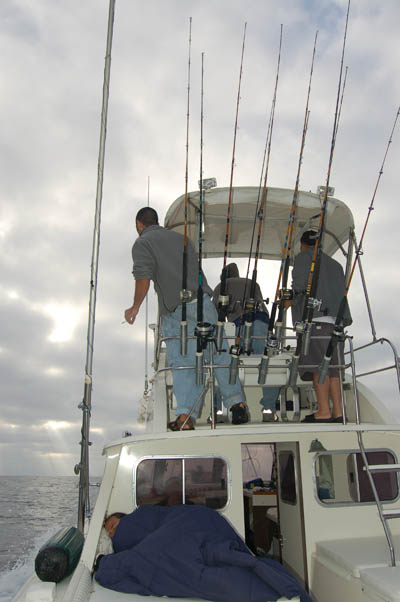
Kelp paddies are hard to find, so every extra pair of eyes helps. We’re also scanning for boils on the surface, whales, and flocks of sea birds that might indicate where the fish might be.
We spot some small whales and dolphins breaching the surface, but they’re loosely grouped together. It doesn’t look like there are any fish with them so we part ways.
We toss in a net full of bait and get our lines in the water next to a paddy in hopes of raising some big fish. Nothing is biting, so we return to the island.
Matt hooks into what he thinks is a tail…
…but ends up being a baby calico. Our bait is bigger than this fish!
Our sardines are too big for the perch and blue bass to swallow, but they like the frozen squid. So do the calicos.
We bag a sheepshead…
…and then all hell breaks loose. Boils appear all around us in every direction. Several large schools of bonita and barracuda swarm up and down the coast, attacking the balls of bait fish. The small anchovies breach the surface in an attempt to flee the ravenous predators. The carnage is an awesome sight to behold, and I am too busy to take a picture. If you have a line in the water, is is almost impossible not to get a fish on your hook! This is the very definition of “wide-open”.
Bonita flop all over the deck, as we pull in fish after fish. The deck becomes a sticky mess of oily, dark blood. The fish stop going after our big sardines, so we switch to iron. Krocodiles and blue and white UFOs are like magnets to the bonita.
A seal is drawn to the commotion, and tries to get our fish as we pull them in. It’s a race to keep our fish away from this persistent pest. Luckily, we’re able to reel them in fast enough to land them intact.
We quickly fill up a sixty gallon cooler with fish, and then top off a separate 40 gallon chest. The boat looks like the scene of a crime, with blood spattered everywhere. We rinse the deck down every few minutes, but new fish just spurt more and more blood everywhere. We limit out on bonita, and decide to start heading home just before 4 in the afternoon.
On the way back, Alex clears what ends up as well over 50 pounds of fillets, and the trail of carcasses attracts a flock of seagulls. One of them goes after a cedar plug that we’re trolling. Luckily, we’re able to get it off the hook relatively unharmed and it flies away.
We come into port just after sunset, clean the boat and our equipment, and head home after a great day of fishing at Catalina.
Puppy blogging
I’m not one to regularly write posts about my pets, but I’ll make an exception because our shih tzus just had puppies. The ultrasound predicted 5 of the little guys, but we ended up with 5 females and 2 males.
Here’s little “Killer” being born. He is clearly the most vocal of the group.

Molly is exhausted after giving birth to 7 little puppies.
Jack, the father, is freaked out by his little squeaking kids. He maintains a good distance away from Molly and his new family, and paces around nervously.
The pups literally fit in the palm of your hands, with room to spare. About the perfect size for a water balloon toss or juggling.
More puppy blogging to follow…
Impossible Fish Tank
I don’t know how this fish tank works exactly, but from what I could understand, the tank on top that joins the adjacent tanks works as a vacuum. The result is that there are feeding holes in the side of the tank, and the water does not flow out. I could not wrap my mind around this technology, but it works.
The fish were swimming between the side tanks over the tunnel. The smarter fish would swim across to the side where we were giving them shrimp.
As you can see, the water stays within the half bowls that are affixed to the side of the tank.
You would think that the water would come gushing out, but it doesn’t. In the words of Arthur C. Clarke, “Any sufficiently advanced technology is indistinguishable from Magic.”. Yup.
These are all fish that you can find off of the coast of Oita.
This guy got a little carried away and jumped out of the tank. He was delicious!
A brightly colored wrasse goes after some krill and misses. Not the most coordinated fish in the tank…
This rockfish was by far the most tenacious fish in the tank. He boxed out all of the other fish, until he had his fill.
The squirrel fish was a bit harder to lure out.
A trigger fish takes his time, and grazes on a shrimp buffet.
This is my favorite picture of the lot. Puffers, box fish, and cowfish all make me happy for some reason. They’re such goofy fish, and tough to boot.
Yufuin Taco Truck
Mexican food is not very popular in Japan, so I was surprised to find a taco truck (a broken down k-jidosha) while walking around the quaint town of Yufuin, Oita.
My father orders a taco from the old lady, and finds out that she learned how to make tacos in Mexico. Tacos don’t get much more ethnic than that…
There is no carne asada, carnitas, biria, lingua, or chile relleno here. The vendor takes out a block of homemade roast beef, and puts a few slices on the grill
We are offered the choice between a white or “brown” tortilla. We go for the brown. The tortilla, much to our delight, is obviously hand made out of whole wheat. A good tortilla is hard to get and can easily cost ten times as much as the going rate in the States(unless you shop at Costco). This is also put on the charcoal grill.
The taco consists of a tortilla, roast beef, onions, tomatoes, cabbage, cucumber, and hot sauce. Irrational as it sounds, I am relieved that there is no fish sausage in the taco. Could that be a surprisingly good combination? No. I don’t think so.
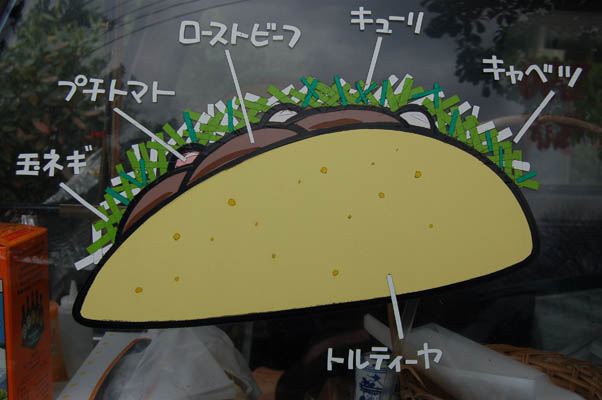
The taco is small, but it is a harbinger of food to come. It’s as if I was destined to eat good Mexican food.
My father enjoys his taco, but reflects that a nice large horchata would be nice. Horchata would probably go over well in Japan. After all, it is made of rice.

